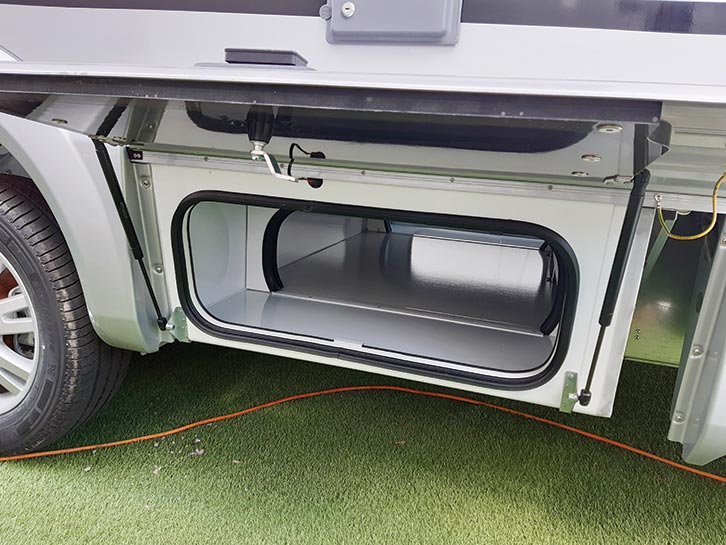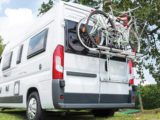One of the many joys of motorcaravanning is being able to take a lot more of your clothes, belongings and accessories with you on your travels. Modern motorhomes are simply packed with brilliant storage options: there are overhead lockers, external hatches, and underseat and underbed spaces. In this guide, we’ll talk you through the process of how to load your motorhome.
How much can you carry in your motorhome?
The starting point is to determine your vehicle’s MTPLM (this is the maximum that it is allowed to weigh when fully loaded) and MiRO (basically, its kerbweight).
The difference between the two figures is your allowable payload: the weight of clothes, food, pots and pans – and passengers – that you can carry in the motorhome on the road.
In addition, you should check the vehicle’s Maximum Axle Weight (MAW). For further information on this check out our guide to understanding motorhome weight limits.
Weight distribution
Once you have confirmed your payload (this is best carried out by taking your unladen motorhome to a weighbridge), loading your vehicle has to be done with weight distribution very much in mind, ensuring that you stick to the Maximum Axle Weights, too.

There are some simple rules to apply here:
- Heavier contents should be stored on the floor of the motorhome, to ensure that you maintain a low and stable centre of gravity.
- This also negates the risk of any weighty items falling out of the overhead lockers and potentially causing serious damage.
- The heaviest items should always be placed close to, or right over, the axles.
- Many island-bed layouts have a huge storage space under the double bed at the back of the motorhome. You should load bulky, but not heavy, items here, because any excessive weight in this position is likely to have a negative effect on the ’van’s handling. Things such as duvets, sleeping bags and other bedding are ideal for being stored underneath the bed.
- Although it is not crucial, try to keep your load roughly even on each side of the motorhome, bearing in mind that there’ll usually be a heavy battery and oven on one side.
- Underseat storage space is often very useful in motorhomes, but always pack the things that you use most often in locations where they are going to be easy to access.
- External lockers are particularly useful on beach holidays, because wet, sandy gear (bodyboards and deflated dinghies) can be securely stored in them without being traipsed through the ’van.
- We like to use those big blue Ikea bags for carrying our clothes when we head off on tour. They are capacious, cheap, lightweight and strong, and will last forever. We each take one and they will swallow huge amounts, then handily squash into underseat storage spaces.

Pets in your motorhome
Rule 57 of The Highway Code states: “When in a vehicle make sure dogs or other animals are suitably restrained so they cannot distract you while you are driving or injure you, or themselves, if you stop quickly. A seat belt harness, pet carrier, dog cage or dog guard are ways of restraining animals in [vehicles].”
In addition, when you’re planning how much kit to pack in your ’van, bear in mind that you’ll need space for your pet’s gear (and food), and for a carrying crate if you choose that method.

Internal motorhome storage
In addition to its wide range of external storage options, HandiWorld produces a couple of very good items for use inside the motorhome.
I particularly like the Car Boot Organiser, a cleverly designed folding polyester storage system that’s as at home (and useful) in your motorhome’s underseat or underbed storage as it is in the boot of your car back home.
Likewise, the Car Back Seat Organiser is really handy for long drives, allowing you to keep maps, glasses and more within easy reach. If you have a smaller campervan, rear-seat passengers can also mount a tablet here to allow them to watch entertainment while you’re on the road.
How to take a bike with you
If you want to enjoy some cycling while you’re on a motorhome trip, you’ll likely also want to take your own bike with you. So what are your options for carrying it?
You could simply store the bike in the aisle in the motorhome. But if you do that, it needs to be carefully tied down to avoid any damage en route. And that becomes a less feasible option if you need to take more than one bike with you.
Bikes can also go tied down in a garage – if you are lucky enough to own a coachbuilt motorhome that includes one. Folded up, they could possibly go in the rear boot area of a van conversion with a fixed bed at the back. But in both cases, you are using up valuable storage space that could well be used for other things.
So sooner or later, you are likely to have to think about whether you should fit a bike rack – and what kind you need. For the most part, the rack will be on the rear of the vehicle. If you’re looking for one, our guide to the best motorhome bike racks is worth a look.

If you drive a campervan, this is a fairly easy option. There are plenty of bike racks out there that are designed to fit the likes of a VW T6. Even with slightly larger van conversions, such as those based on the Fiat Ducato, you should be able to find a good selection to choose from.
Things become a little trickier with coachbuilts. If you have a newer model, and it hasn’t come with a bike rack fitted as standard on the back, chances are, it at least already has fixings for a bike rack on the rear panel, so you should be able to fit one. Do make sure, however, that the bike rack you install does not interfere too much with the vision in any rear-view camera, and that you don’t exceed weight limits on the rear axle.
If you drive a slightly older model and it doesn’t have fixings, that might not be an option for you. Owing to the largely timber-free way in which today’s motorhomes have been constructed, you can’t just nail in a rack any old how.
You might end up needing to have a towbar fitted to your motorhome, and then going for one of the many bike racks that attach to a towbar just as though it had been installed on a car.
No matter which type of bike rack you choose, you must check that carrying bikes will not cause you to exceed your ’van’s payload, or place too much weight on the rear axle.
And remember, if you are also buying a new motorhome, bike racks are just the kind of thing dealers might throw in to tempt you to part with your hard-earned cash. So haggle well!
If you liked this, why not take a look at these:
- We find out about motorhome security and the different options available to keep your ‘van safe
- We pick out the best campervans on the market
Future Publishing Limited, the publisher of Practical Motorhome, provides the information in this article in good faith and makes no representation as to its completeness or accuracy. Individuals carrying out the instructions do so at their own risk and must exercise their independent judgement in determining the appropriateness of the advice to their circumstances. Individuals should take appropriate safety precautions and be aware of the risk of electrocution when dealing with electrical products. To the fullest extent permitted by law, neither Future nor its employees or agents shall have any liability in connection with the use of this information. You should check that any van warranty will not be affected before proceeding with DIY projects.
If you’ve enjoyed reading this article, why not get the latest news, reviews and features delivered direct to your door or inbox every month. Take advantage of our brilliant Practical Motorhome magazine SUBSCRIBERS’ OFFER and SIGN UP TO OUR NEWSLETTER for regular weekly updates on all things motorhome related.









